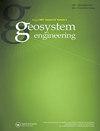Phase formation behavior of alkali-activated calcined clays: effects of the reactive phase and NaOH concentration
IF 1.1
Q3 GEOSCIENCES, MULTIDISCIPLINARY
引用次数: 1
Abstract
ABSTRACT The relevance of calcined clays as sources with a great potential for non-clinker alkali-activated materials has significantly increased in recent decades. This article reports on a study to investigate how NaOH with concentrations in the 5–14 M range affects the mechanical properties, amorphous-crystalline phase transformations, and reaction product composition of alkali-activated calcined kaolinite/montmorillonite cements with reactive phases of 60% and 33%, and with the SiO2/Al2O3 ratios of 1.54 and 1.74. The hardened pastes based on both calcined clays exhibited the highest compressive strength up to 9.1 MPa following their activation with 8 M NaOH. The higher amorphous fraction in the calcined clay provided gradual zeolitisation/crystallisation at Na2O/SiO2 and Na2O/Al2O3 molar ratios in the 0.36–0.63 and 0.56–0.98 ranges, respectively, accompanied by the deterioration of the mechanical characteristics of the samples. The zeolite content in the alkali-activated calcined clay cements with an amorphous fraction of 33% peaked for NaOH at 11 M, and the corresponding molar ratios of Na2O/SiO2 and Na2O/Al2O3 were 0.85 and 1.46, respectively. The main reaction products in the studied systems determined by XRD, TG/DSC, and FTIR spectroscopy analyses were N-A-S-H and zeolite A. The properties and reaction products obtained favor the use of proposed alkali-activated cements for controlled low-strength materials.碱活化煅烧粘土的成相行为:反应相和NaOH浓度的影响
摘要近几十年来,煅烧粘土作为非熟料碱活性材料的巨大潜力来源,其相关性显著增加。本文报道了一项研究,以研究浓度在5–14M范围内的NaOH如何影响碱活化煅烧高岭土/蒙脱石水泥的机械性能、无定形晶相转变和反应产物组成,其中反应相为60%和33%,SiO2/Al2O3比为1.54和1.74。基于两种煅烧粘土的硬化浆体在用8M NaOH活化后表现出最高的抗压强度,高达9.1MPa。煅烧粘土中较高的无定形部分在Na2O/SiO2和Na2O/Al2O3摩尔比分别为0.36–0.63和0.56–0.98的范围内提供了逐渐的沸石化/结晶,同时伴随着样品机械特性的恶化。无定形分数为33%的碱活化煅烧粘土胶结物中的沸石含量在11M时对NaOH达到峰值,Na2O/SiO2和Na2O/Al2O3的相应摩尔比分别为0.85和1.46。通过XRD、TG/DSC和FTIR光谱分析,所研究的体系中的主要反应产物为N-A-S-H和沸石A。所获得的性能和反应产物有利于将所提出的碱活化水泥用于控制低强度材料。
本文章由计算机程序翻译,如有差异,请以英文原文为准。
求助全文
约1分钟内获得全文
求助全文

 求助内容:
求助内容: 应助结果提醒方式:
应助结果提醒方式:


